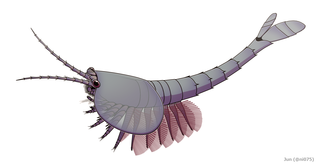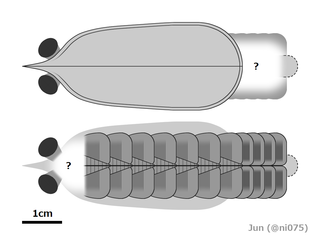
Naraoiidae is a family, of extinct, soft-shelled trilobite-like arthropods, that belongs to the order Nectaspida. Species included in the Naraoiidae are known from the second half of the Lower Cambrian to the end of the Upper Silurian. The total number of collection sites is limited and distributed over a vast period of time: Maotianshan Shale and Balang Formation (China), Burgess Shale and Bertie Formation (Canada), the Šárka Formation, Emu Bay Shale (Australia), Idaho and Utah (USA). This is probably due to the rare occurrence of the right circumstances for soft tissue preservation, needed for these non-calcified exoskeletons.

Yohoia is a genus of tiny, extinct animals from the Cambrian period that has been found as fossils in the Burgess Shale formation of British Columbia, Canada. It has been placed among the arachnomorpha, a group of arthropods that includes the chelicerates and possibly the trilobites. Their sizes range from 7 to 23 mm. 711 specimens of Yohoia are known from the Greater Phyllopod bed, where they comprise 1.35% of the community.

Waptia fieldensis is an extinct species of arthropod from the Middle Cambrian Burgess Shale Lagerstätte of Canada. It grew to a length of about 8 cm (3 in) and resembled modern shrimp in both morphology and habit. It had a large bivalved carapace and a segmented body terminating into a pair of tail flaps. It was an active swimmer, feeding on organic particles it gathered from the seafloor substrate. It is also one of the oldest animals with direct evidence of brood care.

Naraoia is a genus of small to average size marine arthropods within the family Naraoiidae, that lived from the early Cambrian to the late Silurian period. The species are characterized by a large alimentary system and sideways oriented antennas.

Misszhouia is a genus of small to average sized marine arthropods within the Naraoiidae family, that lived during the early Cambrian period. The only species presently known is Misszhouia longicaudata and the holotype was discovered in 1984.
A number of assemblages bear fossil assemblages similar in character to that of the Burgess Shale. While many are also preserved in a similar fashion to the Burgess Shale, the term "Burgess Shale-type fauna" covers assemblages based on taxonomic criteria only.

Acanthomeridion is an extinct arthropod found in the Chengjiang fauna deposits of China. In 1997, it was placed in its own, monotypic family, Acanthomeridiidae. It is known from eight specimens, all found in China.

Alalcomenaeus is one of the most widespread and longest-surviving arthropod genera of the Early and Middle Cambrian. Known from over 300 specimens in the Burgess Shale, and the Chengjiang, it bears great similarity to the opabiniids.

Haikoucaris is a genus of megacheiran arthropod that contains the single species Haikoucaris ercaiensis. It was discovered in the Cambrian Chengjiang biota of China.

Parapaleomerus is a genus of strabopid of small size found in Chengjiang biota, China. It contains one species, P. sinensis. Unlike the other members of Strabopida, Parapaleomerus lacks dorsal eyes and only possesses ten trunk tergites. The telson has been described as trapezoidal. All the trunk tergites are straight and increasingly curve backwards abaxially from T4–10. Specimens of Parapaleomerus sinesis are typically dorsoventrally compressed. The exoskeleton of P. sinensis has a semi-elliptical head shield that lacks any indication of the presence of dorsal eyes. The largest specimen described is recorded as 9.2 cm long, with a maximum width of 9 cm.

Radiodonta is an extinct order of stem-group arthropods that was successful worldwide during the Cambrian period. They may be referred to as radiodonts, radiodontans, radiodontids, anomalocarids, or anomalocaridids, although the latter originally refer to the family Anomalocarididae, which previously included all species of this order but is now restricted to only a few species. Radiodonts are distinguished by their distinctive frontal appendages, which are morphologically diverse and used for a variety of functions. Radiodonts included the earliest large predators known, but they also included sediment sifters and filter feeders. Some of the most famous species of radiodonts are the Cambrian taxa Anomalocaris canadensis, Hurdia victoria, Peytoia nathorsti, Titanokorys gainessii, Cambroraster falcatus and Amplectobelua symbrachiata, the Ordovician Aegirocassis benmoulai and the Devonian Schinderhannes bartelsi.

Eoredlichia is an extinct genus of trilobite of average to large size. It lived during the early Cambrian in the Chengjiang fauna of Yunnan, China, and in Australia and Thailand. Eoredlichia is compounded of the Greek ἠώς and Redlichia, a later but related genus, so it means "early Redlichia". The species epithet intermedia means intermediate, indicating it is morphologically intermediate between other species. Eofallotaspis gives rise to Lemdadella, and thence to Eoredlichia and the other Redlichiidae.

Cucumericrus decoratus is a species of putative radiodont known from a few poorly preserved specimens. Only fragments of trunk cuticle and corresponded appendages had been revealed, while important radiodont features such as frontal appendages are unknown in this species. The trunk cuticle possess irregular wrinkles and may had been soft in life. Each of the trunk appendage compose of a dorsal flap-like element and a ventral stubby leg with unknown distal region, structurally comparable to the trunk appendages of gill lobopodians and euarthropod biramous appendages. The legs have been interpreted as somewhere between annulated lobopod legs and segmented arthropod legs.
Kiisortoqia soperi is a species of arthropod from the Early Cambrian Sirius Passet Lagerstätte in Greenland. Its antennulae resemble anomalocaridid great appendages.

Squamacula is an extinct artiopodan arthropod from the Cambrian Series 2. The type species S. clypeata was described in 1997 from the Chengjiang biota. At the time of description there were only two known specimens of S. clypeata, but now there are at least six known specimens. In 2012 a second species S. buckorum was described from the Emu Bay Shale of Australia.

Luohuilinella is an extinct genus of xandarellid artiopodan arthropod known from the Chengjiang biota of China. The type species Luohuilinella rarus was described in 2012. A second species Luohuilinella deletres was described in 2018. Both taxa are rare components of the assemblage. Like other Xandarellids and most artiopodans, it possessed an unmineralised exoskeleton. The type and currently only known specimen of L. rarus is known from a dorsal exoskeleton, around 17 mm long and 9 mm wide which consists of 27 tergites with pronounced pleural spines. L. deletres is much larger, with specimens being over 10 cm long, L. deletres possessed at least 11 pairs of biramous appendages. Both taxa are dorsoventrally flattened, making a benthic or nektobenthic lifestyle probable. Both taxa have pronounced notches in the cephalon to accommodate the stalked eyes.

Retifacies is an extinct arthropod, that lived in the lower Cambrian. Its fossil remains have been found in China, in the well-known Maotianshan Shales

Cheloniellon is a monotypic genus of cheloniellid arthropod, known only by one species, Cheloniellon calmani, discovered from the Lower Devonian Hunsrück Slate of Germany.

Kylinxia is a genus of extinct arthropod described in 2020. It was described from six specimens discovered in Yu'anshan Formation in southern China. The specimens are assigned to one species Kylinxia zhangi. Dated to 518 million years, the fossils falls under the Cambrian period. Announcing the discovery on 4 November 2020 at a press conference, Zeng Han of the Nanjing Institute of Geology and Paleontology, said that the animal "bridges the evolutionary gap from Anomalocaris to true arthropods and forms a key ‘missing link’ in the origin of arthropods," which was "predicted by Darwin’s evolutionary theory." The same day the formal description was published in Nature.

Erratus is an extinct genus of marine arthropod from the Cambrian of China. Its type and only species is Erratus sperare. Erratus occupies a transitional position between lobopodians and true arthropods, and its discovery has helped scientists understand the early evolution of arthropod trunk appendages. Some of the stem-arthropods like radiodonts did not have legs, instead they had flap like appendages that helped them swim. Erratus on the other hand had not only flaps but also a set of primitive legs. It also supported the theory that the gills of aquatic arthropods probably evolved into the wings and lungs of terrestrial arthropods later in the Paleozoic.


















